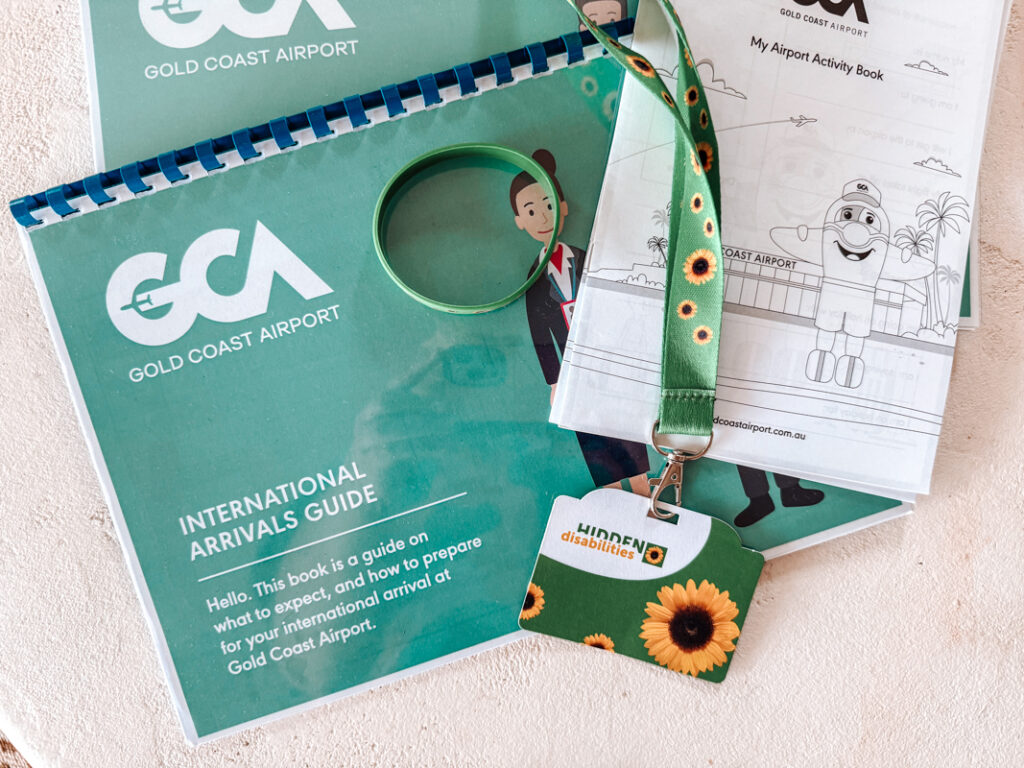
As a mum of a neurodivergent daughter who travels regularly, I know the challenges that can come with traveling, especially through airports. So, when I saw that Gold Coast Airport had developed an initiative to support neurodivergent (ND) travellers, I wanted to know more, so I set up a time to catch up with the team and learn more about their Hidden Disabilities program.
From personal experience, with a daughter who is neurodivergent, routine has always been our friend. Kids, and people in general, with ND, tend to like routine. The chaos of airports can be really triggering, with completely new smells, sounds (often loud), inflexible processes (like the screening process where we have to let of any aids or toys for screening), and the large crowds. Even for a neurotypical traveller, these factors can be really stressful.
Many airports around the world have adopted the Hidden Disabilities initiative, where they’ve put in some practices to make travel a little easier for people with neurodiversity. My husband works at the Gold Coast Airport (as a Federal Police Officer), so I got to hear first hand about the great things they were doing, so I made an appointment to meet with the team and learn more because I was curious and delighted that they’d consider people like my own daughter.
7 ways Gold Coast Airport IS MAKING TRAVEL easieR
Sunflower Lanyards and Wrist Bands
Around the world 1.3 billion people live with a disability, but for many it’s not a visible disability, which is often the case for people who are neurodivergent. The Hidden Disabilities Sunflower is a tool that people can voluntarily wear to share that they have a disability that isn’t immediately obvious, and that they made need a little more time or understanding, especially in public spaces.
If you’re travelling through the Gold Coast Airport at any stage, you can visit their website and let them know, and they can equip you with a kit that includes a sunflower lanyard to wear during the visit. This is complimentary, you’ll just need to pop in your details including your flight number.
Alternatively you can purchase from Hidden Disabilities, which I have also done in the past.

Terminal Sensory Map
Information is power, so this map shows which areas are low, medium and high sensory areas. Airports are noisy, so it can help you find areas that are less crowded and noisy. If you’re traveling domestically, as you finish screening, head left past Hungry Jacks towards the International terminal. Just before you get to the escalators, you’ll find a large sitting area that I find to be quiet and peaceful, and gives space for active kids to burn energy (or ride the escalators), and away from the smells and noises of the cafes and restaurants.
Social Story Guides and Activity Books
Gold Coast Airport has also created Social Story Guides to take your neurodivergent family member through the step-by-step process of visiting an airport, before you get there. This includes small, yet important details on the screening process, what it’s like on the tarmac, and even the check-in process. You can check them out here.
Ambassa-Paw Program
Dogs! Let’s talk about dogs! GCA (Gold Coast Airport) has volunteer therapy dogs that stroll through the airport with their volunteers (when the dogs are available), and they can be approached, cuddled, and patted, and used as a tool to ease the stress for anxious travellers.
Neurodivergent-friendly Bathrooms
The change I really appreciated the most, was the simple change of making accommodations in bathrooms to make them more ND-friendly by removing the noisy hand-dryer and replacing with simple paper towel. For many ND people, the noise of the hand-dryer is too much. The bathrooms that have been changed are marked with a sunflower on the door.
Safe space rooms
Just near the screening point at the Gold Coast Airport, is a small room that is ideal if your child is overwhelmed, overstimulated or you just want to calm down in the time between check-in and screening. The door is marked with a Hidden Disability Sunflower and accessible to anyone. The room features seating, dimmable lighting, and space to just catch your breath before moving into the secure area.
Trained Empathetic Staff
Personally, I have found that when people don’t know they think that we’re being fussy or over-the-top about out ND kids’ needs. Humans are complex being with varied needs, neurodivergent or not, and I really don’t think it takes much to be a little accommodating. You’ll find that some of the staff around the airport wear a sunflower on their lanyard, and this means that they’ve been trained on Hidden Disabilities, and will have some level of understanding on how they can support you. (There are also many people, including my husband, who hasn’t been equipped with the badge but have training and understanding on how to best assist people with Hidden Disabilities – so wearing the sunflower lanyard can help open up an understanding and support that might be needed). While the screening point is inflexible for legal reasons, they can make accommodations for people with Hidden Disabilities to make the process smoother and calmer, where possible.
The Gold Coast Airport has been undergoing renovations for a while now, and is looking and feeling really beautiful, and they have more initiatives in the works for their Hidden Disabilities Program. If you want to know anymore, you can visit their website.

